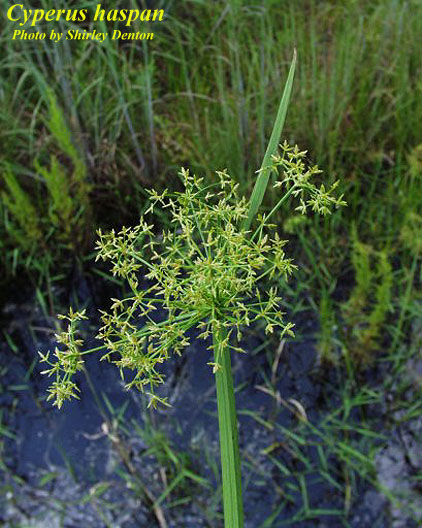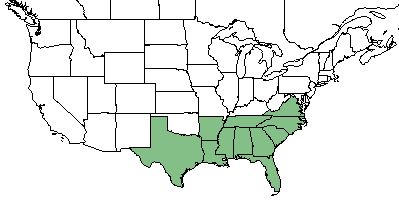Cyperus haspan
Common names: Haspan Flatsedge [1] , Shethed Flatsedge [2]
| Cyperus haspan | |
|---|---|

| |
| Photo by the Atlas of Florida Plants Database | |
| Scientific classification | |
| Kingdom: | Plantae |
| Division: | Magnoliophyta - Flowering plants |
| Class: | Liliopsida - Moncots |
| Order: | Cyperales |
| Family: | Cyperaceae |
| Genus: | Cyperus |
| Species: | C. haspan |
| Binomial name | |
| Cyperus haspan L. | |

| |
| Natural range of Cyperus haspan from USDA NRCS Plants Database. | |
Contents
Taxonomic Notes
Synonym: C. haspan L. var. americanus Bockler.[3]
Variety: none.[3]
Description
C. haspan is a perennial graminoid of the Cyperaceae family that is native to North America. [1]
Distribution
C. haspan is natively distributed across the southeastern region of the United States; from Florida north to Virginia and west to Texas. It is also native to Puerto Rico and the Pacific Basin, and has been introduced to Hawaii.[1]
Ecology
Habitat
Common habitats for C. haspan is in tidal marshes, low fields, ditches, and waterfowl impoundments. It requires full sunlight, it has littler tolerance for shaded regions.[1][4] Cyperus haspan has been found to grow well in subtropical and tropical climates and being of the most productive plants in the regions wetlands. [5] Habitats also include wet prairies, broadleaf marshes, and wetland shrubs. They are found to germinate well in flooded environments. [6] Specimens have been collected in the following habitats; river banks, moist loamy sands, pine flatwood clearings, ponds, shallow water, hillside bogs. [7]
Associated species: Xyris sp., Fuirena sp., Rhynchospora sp., Gratiola pilosa, Eryngium integrifolium, Juncus canadensis, Thelypteris palustris, Lorinsera areolata, Smilax laurifolia, Itea virginica, Aronia arbutifolia, Lyonia ligustrina, and Viburnum nudum.[8][9]
Phenology
C. haspan has been observed to flower between April and September. Seeds begin to disperse during the summer months. [1][10]
Fire ecology
Cyperus haspan has a tolerance for low intensity fires.[1]
Use by animals
This species has been observed to be eaten by white-tailed deer.[11]
Conservation and Management
C. haspan is considered to be possibly weedy or invasive by the Hawaiian Ecosystems at Risk Project.[1]
Cultivation and restoration
Has been used in landfill restoration areas. [12]
Photo Gallery
References and notes
- ↑ 1.0 1.1 1.2 1.3 1.4 1.5 1.6 USDA Plant Database
- ↑ Orzell, S. L. and E. L. Bridges (2006). "Floristic composition of the south-central Florida dry prairie landscape." Florida Ecosystem 1(3): 123-133.
- ↑ 3.0 3.1 Weakley, A.S. 2015. Flora of the southern and mid-atlantic states. Working Draft of 21 May 2015. University of North Carolina at Chapel Hill, Chapel Hill, North Carolina.
- ↑ Weakley, A. S. (2015). Flora of the Southern and Mid-Atlantic States. Chapel Hill, NC, University of North Carolina Herbarium.
- ↑ Akinbile, C., et al. (2012). "Landfill leachate treatment using sub-surface flow constructed wetland by Cyperus haspan." Elsevier.
- ↑ Wetzel, P., et al. (2001). "Restoration of wetland vegetation on the Kissimmee River Floodplain: Potential role of seed banks." Wetlands 21(2): 189-198.
- ↑ URL: http://herbarium.bio.fsu.edu. Last accessed: June 2018. Collectors: Sydney Thompson, Culver Gidden, Loran C. Anderson, T. MacClendon, K. MacClendon, R.K. Godfrey, D. B. Ward, D. Burch, R. Kral, States and counties: Florida (Wakulla, Calhoun, Charlotte, Columbia, Dade, Escambia)
- ↑ Morris, M. W. (1988). "Noteworthy vascular plants from Grenada County, Mississippi." SIDA, Contributions to Botany 13 (2): 177-186.
- ↑ (1988). "Four new records of Cyperus (Cyperaceae) in Arkansas." SIDA, Contributions to Botany 13(2): 259-261.
- ↑ Nelson, G. PanFlora: Plant data for the eastern United States with emphasis on the Southeastern Coastal Plains, Florida, and the Florida Panhandle. www.gilnelson.com/PanFlora/ Accessed: 18 MAY 2018
- ↑ Harlow, R. F. (1961). "Fall and winter foods of Florida white-tailed deer." The Quarterly Journal of the Florida Academy of Sciences 24(1): 19-38.
- ↑ Akinbile, C., et al. (2012). "Landfill leachate treatment using sub-surface flow constructed wetland by Cyperus haspan." Elsevier.